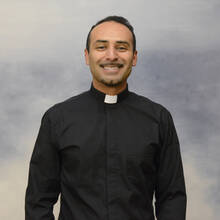A Wounded Healer for a Wounded World
The Christian understanding of the resurrection developed over time, and snapshots of that development appear throughout the New Testament. The earliest scriptural witnesses to the resurrection take the form of brief proclamations of belief (see Rom 1:4; Mk 8:31). In other passages, like 1 Cor 15:3-7, creeds and other structured statements of belief reveal a Christian community that had reflected on the resurrection and its implications in their lives. A number of Gospel passages show even greater reflection as proclamations and statements become fully developed narratives that explore the significance of Christ’s resurrection.
Unless I see the mark of the nails in his hands and put my finger into the nail marks and put my hand into his side, I will not believe. (Jn 20:25)
How will you live out the prayer of peace in your life today?
Where is the power of the wounded healer needed most today?
Do you ever find yourself identifying with a disbelieving Thomas?
On this, the second Sunday of Easter, the Gospel reading recounts the way that Jesus transformed a fearful group of disciples. “The doors were locked, where the disciples were, for fear of the Jews” (Jn 20:19). In the midst of this sad scene, Jesus greets them with the phrase, “Peace-with-you.” This common expression, in Hebrew, shalom alekem, was a normal greeting among friends and neighbors in ancient Israel. Jesus’ surprising presence makes this post-resurrection scene anything but normal, however. This has prompted some scholars to hear an eschatological nuance in his greeting: “Peace is now with you.” The greeting is no longer a pious hope, but a declaration of fact. Jesus’ death and resurrection has ushered in a new era in which peace is the possession of any disciple who believes.
In other words, what this Gospel passage communicates is more than a consoling greeting in a time of fear. The passage reminds readers of every generation that those first disciples already had peace because the God of peace was with them even in locked-up rooms. Their fear is both real but also unnecessary, and Jesus makes that clear in his greeting, “You have peace.”
This bold proclamation of peace came at a cost. In John’s account, Jesus declares his peace even as he reveals his wounds. The image is striking. After Jesus’ greeting, “he showed them his hands and his side” (Jn 20:20). This is followed by a second reminder, “Peace-with-you.” When Thomas later has the chance to touch Jesus, it is contact with the wounds that inspires the belief necessary for him to receive Christ’s peace. “My Lord and my God,” declares Thomas, to the benefit of all who will encounter this scene in Scripture (Jn 20:28).
What do Jesus’ wounds have to do with the peace he brings into the world? John the evangelist does not answer explicitly, but he suggests two possibilities. Christ’s gift to the disciples is a perpetual peace, one in fact that they have always had from God but have forgotten about because of their fear. Second, it is belief in Jesus’ death and resurrection that drives fear away and allows those who put their faith in Christ to experience the peace that was always their inheritance. The same peace is available to Christ’s disciples today. In whatever corner of our wounded world we find ourselves, solace is always available for us and through us in the power of Jesus Christ, the wounded healer.








